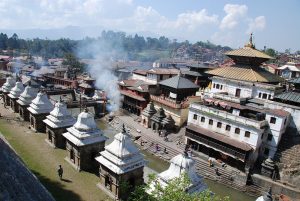Pashupatinath Temple complex
About the temple
- Pashupatinath Temple is the largest temple complex in Nepal and stretches on both sides of the Bagmati River.
- It sees thousands of worshippers from Nepal and India every day.
- Dedicated to Lord Shiva, Pashupatinath is one of the four most important religious sites in Asia for devotees of Shiva.
- The temple was built in the 5th century AD and later renovated by Malla kings.
- The main temple is built in a pagoda styled inside a fortified courtyard.
- Pagoda is a towerlike, multistory, solid or hollow structure made of stone, brick, or wood.
- The temple is also listed under the UNESCO World Heritage site.

Why in News?
- India has pledged to construct a Rs 2.33 crore sanitation facility at the iconic Pashupatinath Temple complex to improve the infrastructure in the holy shrine for the pilgrims.
- The project would be constructed under the Nepal-Bharat Maitri: Development Partnership as a high impact community development scheme by India.
- India’s assistance for the infrastructure development at the Pashupatinath Temple complex comes amid a raging border row between the two countries.
UNESCO World Heritage site
- A World Heritage Site is a landmark or area, selected by the United Nations Educational, Scientific and Cultural Organization (UNESCO) for having cultural, historical, scientific or other form of significance, which is legally protected by international treaties.
UNESCO’s World Heritage Convention, 1972
- The Convention Concerning the Protection of the World Cultural and Natural Heritage is an international agreement that was adopted by the General Conference of UNESCO in 1972.
- It is based on the premise that certain places on Earth are of outstanding universal value and should therefore form part of the common heritage of humankind.
- It basically defines the kind of natural or cultural sites which can be considered for inscription on the World Heritage List.
- The Convention sets out the duties of State Parties in identifying potential sites and their role in protecting and preserving them.
- By signing the Convention, each country pledges to conserve not only the World Heritage sites situated on its territory, but also to protect its national heritage.
- It explains how the World Heritage Fund is to be used and managed and under what conditions international financial assistance may be provided.
UNESCO Cultural sites in India (30)
- Agra Fort
- Ajanta Caves
- Archaeological Site of Nalanda Mahavihara at Nalanda, Bihar
- Buddhist Monuments at Sanchi
- Champaner-Pavagadh Archaeological Park
- Chhatrapati Shivaji Terminus (formerly Victoria Terminus)
- Churches and Convents of Goa
- Elephanta Caves
- Ellora Caves
- Fatehpur Sikri
- Great Living Chola Temples
- Group of Monuments at Hampi
- Group of Monuments at Mahabalipuram
- Group of Monuments at Pattadakal
- Hill Forts of Rajasthan
- Historic City of Ahmedabad
- Humayun’s Tomb, Delhi
- Jaipur City, Rajasthan
- Khajuraho Group of Monuments
- Mahabodhi Temple Complex at Bodh Gaya
- Mountain Railways of India
- Qutb Minar and its Monuments, Delhi
- Rani-ki-Vav (the Queen’s Stepwell) at Patan, Gujarat
- Red Fort Complex
- Rock Shelters of Bhimbetka
- Sun Temple, Konârk
- Taj Mahal
- The Architectural Work of Le Corbusier, an Outstanding Contribution to the Modern Movement
- The Jantar Mantar, Jaipur
- Victorian Gothic and Art Deco Ensembles of Mumbai
UNESCO Natural sites in India (7)
- Great Himalayan National Park Conservation Area
- Kaziranga National Park
- Keoladeo National Park
- Manas Wildlife Sanctuary
- Nanda Devi and Valley of Flowers National Parks
- Sundarbans National Park
- Western Ghats
Mixed site (1)
- Khangchendzonga National Park
Subscribe
Login
0 Comments
